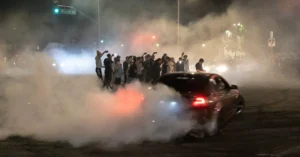Sideshows dirt-bike gangs could soon see stiffer penalties in…

In many urban locations, sideshows and dirt-bike gangs have long been a source of conflict and danger. Law enforcement and legislators are becoming more and more interested in these unlawful events, which are marked by high-speed stunts, careless driving, and disturbances in public spaces. Stricter punishments for sideshow and dirt-bike gang members are being considered or have already been imposed by a number of towns and states in response to growing concerns about public safety. This change attempts to improve community safety by addressing the risky behaviors connected to these groups.
Sideshows are unofficial, unplanned car and motorcycle events that frequently feature participants pulling off risky stunts like wheelies, drifting, and burnouts. These gatherings have the potential to swiftly turn into chaotic scenes with sizable people, boisterous music, and frequent property damage. The impromptu quality of sideshows, along with their legal status, poses formidable obstacles for police enforcement. It is challenging for officers to control the situation and guarantee public safety because they are frequently compelled to respond to these gatherings after they have already started.
Similar to this, groups that ride off-road motorcycles on public streets and highways are known as dirt-bike gangs, and they break traffic laws and produce dangerous situations. These riders often act recklessly, doing things like doing stunts, swerving in and out of traffic, and running red light after red light. Their actions put them in danger, but they also put other drivers at risk, which can result in collisions and casualties. In addition, these gangs’ property destruction and noise pollution make the issue worse.
Several jurisdictions are moving toward enacting harsher sanctions for members of dirt-bike gangs and sideshows in light of these problems. Significantly higher fines, longer auto impoundment times, and possibly jail time for repeat offenders are among the proposed remedies. A few localities are also thinking about passing laws that would make it possible to seize cars that are being used illegally. The purpose of these suggested punishments is to severely penalize criminal action in order to discourage people from planning or taking part in these risky gatherings.
There are two reasons for these suggested actions. The primary goal of these measures is to improve public safety. More severe sanctions, according to law enforcement and local leaders, are required to effectively discourage involvement in sideshows and unlawful dirt-bike riding. Authorities intend to lessen the number and intensity of these occurrences by enforcing stricter penalties, which will lessen the hazards and disruptions that come with them.
Furthermore, these legal modifications are a part of a larger plan to deal with the underlying causes of these problems. To give youth safer and legal outlets for their interests and energy, several communities are investing in community outreach initiatives and other leisure pursuits. These programs are meant to draw potential participants away from illicit activity by providing interesting and beneficial substitutes.
Despite these initiatives, there has been a great deal of discussion about the planned punishments. Opponents contend that merely concentrating on punitive measures could fail to solve the underlying social and economic issues that motivate people to join dirt-bike gangs and sideshows. These illicit activities may be more appealing due to factors including lack of community involvement, economic inequality, and restricted access to recreational facilities. Opponents argue for a more all-encompassing strategy that successfully addresses these underlying issues by combining enforcement with preventative actions and support networks.
Concerns exist over the possible effects of stiffer sanctions on communities as well. Some contend that severe punishments can disproportionately harm vulnerable populations and make already-existing injustices in the legal system worse. They contend that a well-rounded strategy that includes community support in addition to enforcement would be more successful in solving the issue and reducing any unfavorable effects.
In conclusion, there has been a noticeable change in the way that law enforcement handles these risky and disruptive activities with the demand for harsher punishments for sideshows and dirt-bike gangs. Law enforcement officials hope to improve public safety and discourage criminal activity by enforcing harsher penalties. The way these policies are put into practice and whether or not they are supplemented by initiatives that deal with the underlying societal problems that are driving these behaviors will determine how effective these measures wind up being. To address these urgent issues, a comprehensive strategy that incorporates community involvement and support with enforcement will be essential to developing long-term solutions.

Leave a Reply